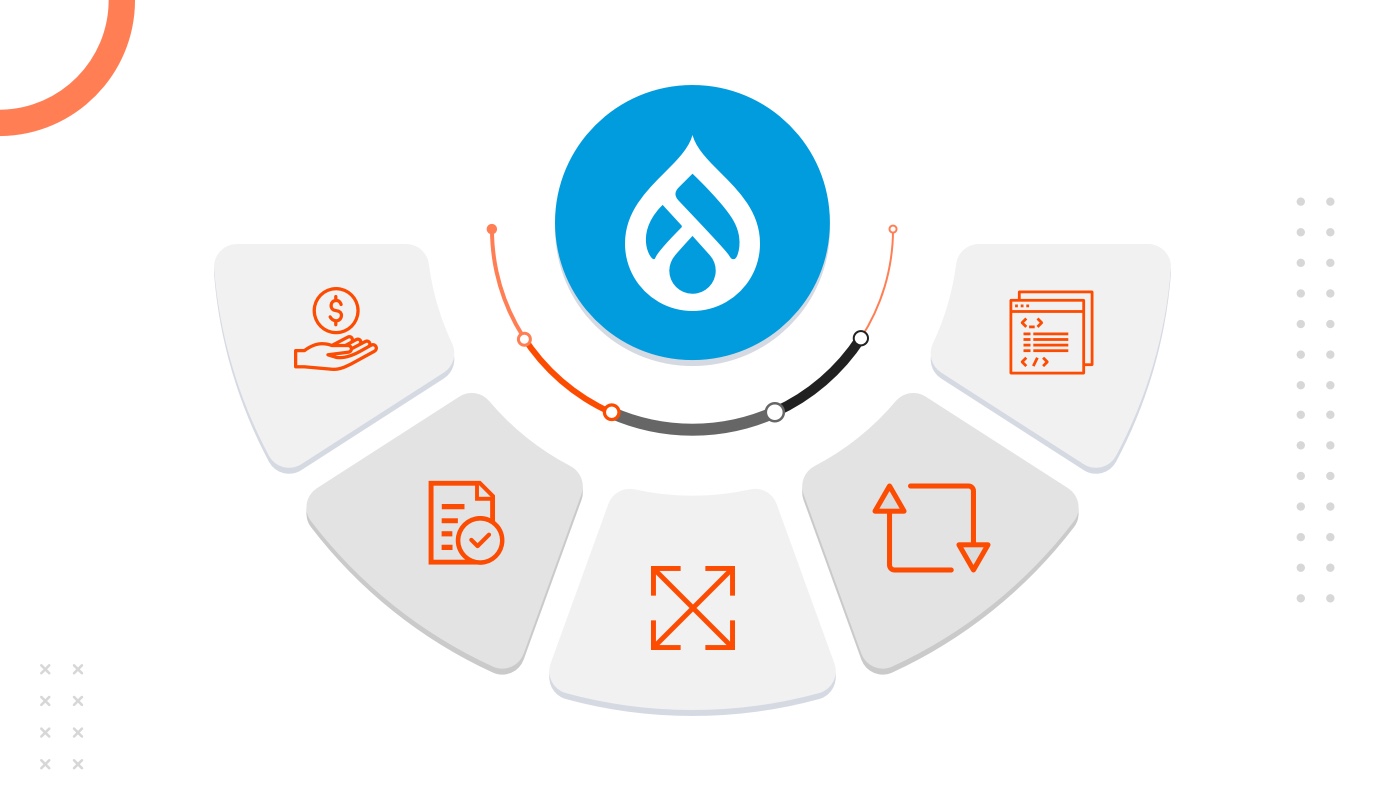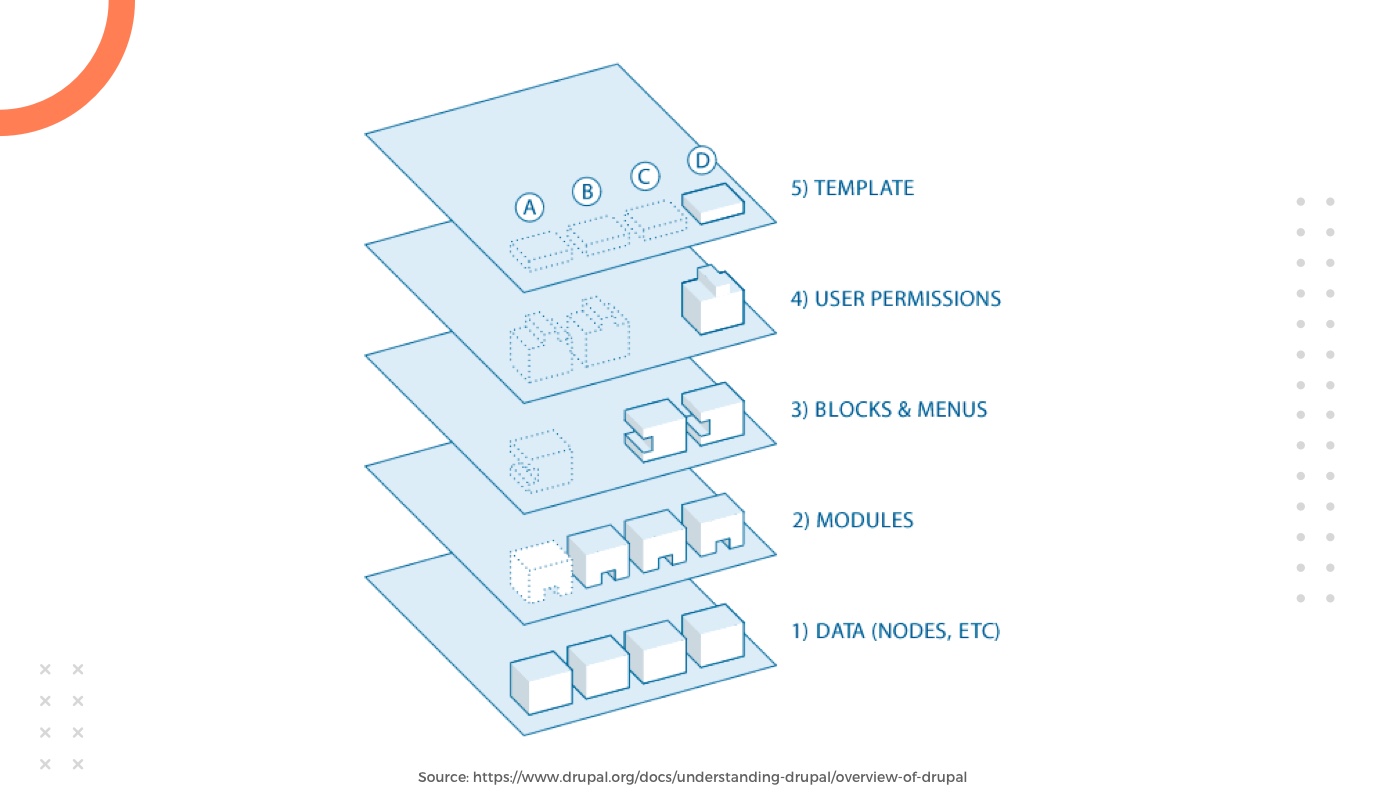Introduction
Meeting customer demands for personalized user experiences is paramount for businesses. To achieve this, adopting a mobile-first approach and ensuring swift responses becomes mission-critical.
With users increasingly seeking engaging and interactive elements in their web experiences, organizations must choose a content management system (CMS) that aligns seamlessly with their requirements.
Drupal is a preferred CMS for web application development, known for its open-source nature and high-security standards.
The Significance of Drupal in Web Application Development:
Drupal, an open-source and highly secure CMS, is pivotal in crafting robust web applications. Renowned brands like Johnson & Johnson, General Electric, and eBay trust Drupal website development to deliver exceptional digital experiences. But why is Drupal the go-to choice for industry leaders in web application development? Let's delve into the reasons:
Unveiling the Power of Drupal Development: Why should you consider using Drupal to build a web application?

When organizations embark on web application development, they seek a content management platform that is secure, reliable, and flexible. As an open-source CMS platform, Drupal is the trusted choice for small-to-large organizations globally, including Nasdaq, Cisco, and Tesla. Its reputation for innovation and scalability is supported by community-driven code and a robust architecture tailored to meet enterprise requirements.
Here's a closer look at why Drupal is an ideal choice for web application development in 2024:
Flexibility at its Core
Drupal provides a robust framework for creating precise web applications. With its core components and APIs, Drupal seamlessly accommodates complex web applications. The key lies in utilizing suitable modules to attain specific functionalities. Here are some crucial modules that help build a web application:
|
Module Name |
Functionality |
|
This module plays a crucial role in defining the configuration sets to separate directories at the time of export and merge them at the time of import. |
|
|
Every time a new draft is created, this module offers a tab that reflects all the revisions and makes it easy to view all the words that have been added, modified, and deleted. |
|
|
This module enables you to define specific patterns for content the moment it gets created. For example, in the case of a blog content type, this module automatically lets you add /blog in the URL. |
|
|
By elevating the administrative user experience, this module offers a drop-down menu that makes it easy to access the different administration pages. |
|
|
This module streamlines the redirect handling process in Drupal by automatically building a redirect for every content piece with an updated path. |
Be it event registrations, insightful analytics, or interactive videos, Drupal has got you covered! You can also combine different modules according to your needs. Just like LEGO, Drupal empowers you with a myriad of blocks that allow you to build whatever you want.
Why is Drupal Flexible?
Drupal's flexibility extends beyond its core functionalities, with over 48,000 community-contributed modules. These modules offer plug-and-play functionality and help tailor web applications based on the specifications provided. From gaining insights through Google Analytics to ensuring GDPR compliance for cookies, Drupal has a dedicated module for every need.
Customer-centric user experience
Drupal simplifies the delivery of customer-focused digital experiences.
It empowers organizations to create web applications that meet visitor needs, aiding informed decision-making. The user interface is meticulously crafted with the customer in mind, ensuring personalized and customer-centric interactions. The goal is to deliver a unique experience that fulfills users' specific needs throughout their journey.
Drupal web development offers unparalleled flexibility, security, and a customer-centric approach, making it the ideal choice for organizations aiming to elevate their digital experiences.

A Success Story: Accelerating Web Development with Drupal
Empowering a Fortune 200 Life Sciences Company
A Fortune 200 Life Sciences Company engaged in groundbreaking R&D activities faced the challenge of creating a powerful multisite platform with an impeccable user interface.
With over 400 companies under its umbrella, geographical diversity posed a unique challenge, necessitating a seamless web solution. After encountering challenges with a previous vendor regarding the technical intricacies of Drupal and Site Factory, the life sciences company turned to Axelerant for a solution.
Their objectives included reducing launch times, achieving cost savings, and enhancing collaboration. Read how Axelerant leveraged the power of the Site Factory and Site Studio to develop a robust tool for delivering consistent brand experiences as well as personalized user journeys to their visitors.
How does Drupal deliver a customer-centric user experience?
Drupal is enriched with various built-in modules. This makes Drupal CMS development an ideal choice for the following factors:
Personalization Modules – Drupal boasts built-in modules, including Personalization Module, Commerce Recommender, and Browsing History Recommender, enabling tailored user experiences.
Despite a preference for JavaScript-based solutions, Drupal's open-source options shine. Read how Axelerant seamlessly integrated Site Studio and the Context module to drive personalization in Drupal applications, offering a comprehensive solution.
Caching Optimization – Drupal's Internal Page Caching and Internal Dynamic Page Cache modules elevate speed and page load efficiency. Anonymous visitors experience faster loading times as pages are cached intelligently, ensuring a smoother user experience.
Built-in block system – Drupal's block system allows effortless rearrangement of a web application's layout by dragging and dropping required blocks. This helps ensure design uniformity and content reuse across multiple pages.
WYSIWYG editor – The WYSIWYG editor in Drupal empowers users to preview text and images before publishing, enhancing the content creation process.
Responsive design – Drupal's responsive design ensures a seamless experience across devices, whether accessed through smartphones, desktops, or tablets.
Social media modules – Drupal simplifies social media connectivity with various integration modules, facilitating easy linking to platforms like Twitter and Facebook directly from the web application.
API-Friendly Architecture
Drupal's API-first initiative facilitates content creation and management, catering to various front-end applications. Its API-friendly architecture, including RESTful Web Services API, JSON: API, Render API, and Translation API, ensures a streamlined and enriched customer journey.
What makes Drupal API-friendly?
Every modern CMS should ideally have access to robust APIs and integrate them across every stage of the customer journey for a better experience. The latest releases of Drupal have announced various APIs like:
RESTful Web Services API - It is known for supporting a decoupled Drupal website. It is responsible for the communication between native mobile applications and a specific Drupal website. Also, it takes care of web services integration.
JSON:API - This module has simplified integrations by allowing serialization and communication through JSON.
Render API - It includes improved caching protocols and ensures faster page rendering to elevate the overall user experience.
Translation API - This Drupal API plays a vital role in adjusting the language on the web application according to prospect/visitor geographies.
SEO Optimization
Since Drupal 7, the platform has excelled in SEO optimization. Leveraging semantic structure and RDF support, Drupal optimizes content for search engines, utilizing alt and title tags effectively. A Forrester report acknowledges Drupal's semantic approach as crucial for content managers and authors, further solidifying its position as a leading CMS for SEO.
An Interesting Story: Transforming Legacy.com's Editorial Section with Drupal
Empowering the editorial segment of Legacy.com's global online obituaries platform has been a remarkable journey. With partnerships spanning 1,500+ newspapers and 3,500 funeral homes, Legacy.com serves 40 million unique visitors monthly. Facing the challenge of launching Drupal CMS development within six months, Read how Axelerant collaborated with Facet Interactive to deliver an enterprise-level headless Drupal platform, optimizing media organization, content publishing speed, and comprehensive support for newspapers.
Drupal's Search Engine Friendliness Unveiled:
SEO Modules:
Drupal's SEO prowess extends through modules such as SEO checklist, XML Sitemap, Global Redirect, SEO compliance checker, and Pathauto. The Metatag module stands out, enabling the effortless addition of meta tags to enhance SEO. Notably, it allows control over content appearance on social media channels, adding an extra layer of SEO value.
Intuitive Taxonomy System:
Drupal's flexible taxonomy system simplifies content organization using keywords. This not only aids in organizing information thematically but also ensures user-friendly navigation through search terms.
Unmatched Security
Being an open-source CMS platform, Drupal's codebase is always closely scrutinized. As the code powered by Drupal is freely available to everyone for review, use, modification, as well as contribution, it's imperative to ensure that the code is top-notch. Since there are millions of people contributing to this code, it is invigilated by a large number of eyes worldwide which leads to optimum security.
In the case of using a closed source CMS platform, there is no clarity about the potential security flaws present within the software. Due to its ability to handle extremely crucial data, Drupal has been a preferred CMS for web applications that are created for government, leading financial institutions, and popular e-commerce brands.
Why is Drupal so secure?
To give your web application a high level of security, Drupal comes with a list of various security modules that include:
Drupal Login Security – This module enables the administrator to impose several restrictions on user login. Before blocking an account, it can restrict the total number of invalid login attempts made. Also, it allows administrators to deny access to specific IP addresses.
Two-factor Authentication – Leveraging this security module by Drupal, you can get a dual-layer of authentication after a user logs in to your application with a specific user ID and password. This involves entering a code received on their email or mobile phone.
Password Policy – This module by Drupal plays a key role in making your login forms more secure, thereby keeping bots and possible security breaches at bay. It enforces various restrictions at the time of password setting, such as constraints on the character type, length, case included (uppercase/lowercase), etc. Also, it comes with a password expiration feature that asks users to regularly change their passwords.
Content Access – This module allows you to gain access control to the content in a detailed manner. By specifying the content types with a view, edit, or delete permissions, you can manage them on the basis of role and author.
Coder – If there are any loopholes in your code, an attacker is likely to steal your information. By using the Coder module, your Drupal code is properly scrutinized to uncover the areas where the coding practices aren't followed properly.
Read more about the different security modules powered by Drupal.
Uncovering the flow of Drupal
Before considering Drupal website development, it's essential to take a sneak peek into the system's layers between which the information is passed. Drupal comes with a set of 5 layers, namely:

Data (Nodes, etc.)
At the foundation lies the data layer, encompassing all nodes and serving as the data pool where information is input before display.
Modules
The second layer in the Drupal flow is modules. Modules can be defined as the functional plugins that are built on the core functionality of Drupal. They can either be a component of the Drupal core (when shipped with Drupal) or contributed items that are specially developed by Drupal community members. These modules enable you to seamlessly customize the data items on your specific node types, create e-commerce from scratch, sort and display the required content programmatically, and more. There is a myriad of options in the continuously evolving repository of the Drupal modules that indicate innovation as well as the collaborative effort of the community members.
Blocks & Menus
The next layer in the Drupal Development flow comprises blocks and menus. Blocks are used for gaining output from a particular module and are mainly created to represent anything you want. These blocks can be placed in several spots (called regions) inside the template layout that you use and can be effortlessly configured to output in different ways. Menus are used for navigation in Drupal that help to define the content that comes in each respective menu path (i.e. the relative URL). These play a crucial role in providing links to all the different pages that have been created in Drupal.
User Permissions
In this stage, the settings are configured to control what different users can see and are allowed to do. These permissions are usually defined on the basis of specific roles due to which different users are granted different defined permissions.
Template
This layer involves the site theme and is mainly made up of XHTML and CSS. Due to the intermixing of the Twig variables, the content generated in Drupal can easily go into the relevant spots. With each theme, there's a defined set of functions used for overriding the standard ones in the listed modules. This helps to gain full control over how different modules create their markups during the output.
Conclusion
Drupal's search engine friendliness, unmatched security features, and layered flow make it an unparalleled choice for web application development. As the digital soul of the brand, your web application deserves the modular excellence and robust configurations that Drupal offers. If you are seeking exceptional Drupal web application development services, connect with Axelerant's experts to learn more.

Sahaj Sharma, Senior Content Marketer
A shopaholic and big-time foodie, Sahaj explores and enjoys different cuisines, loves to watch movies, travels, and paints. Honesty tops his list of essential values. He works in a routine and appreciates aesthetics and creativity.

 We respect your privacy. Your information is safe.
We respect your privacy. Your information is safe.



Leave us a comment